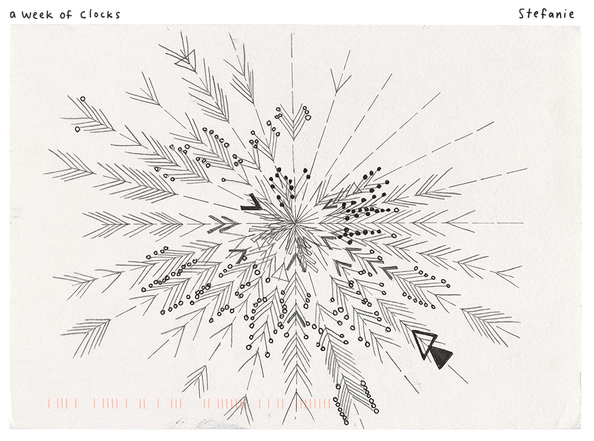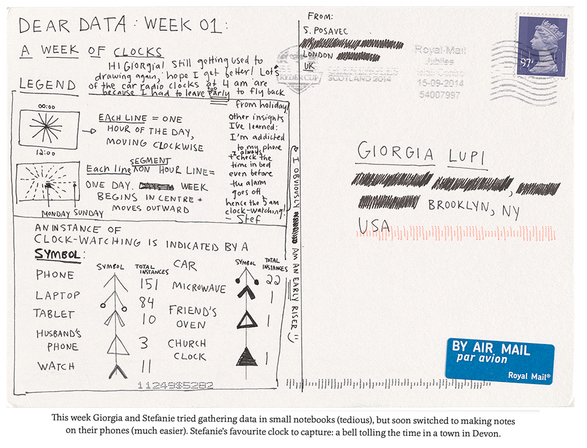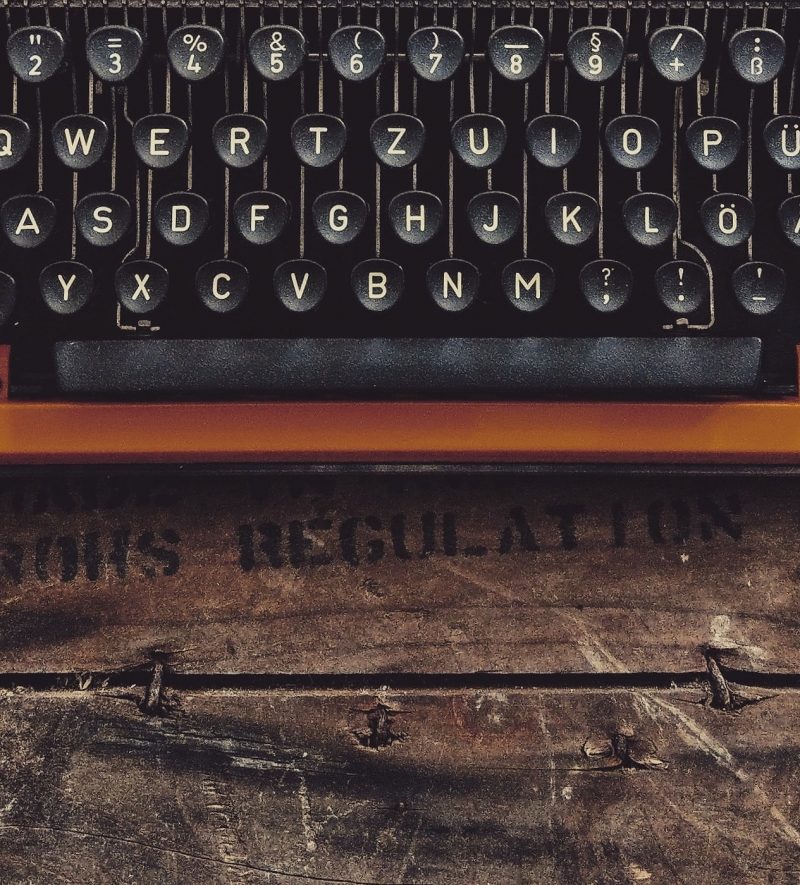One
Instructions
Spend one day recording your “personal data” in at least three different categories of your choosing. Possibilities include but are not limited to: how many times you walked across the quad by hour, how many times you opened iMessage on your laptop, or how often you apologized. Visualize this data in some way, with an explanation for how the how to read your visualization. (For example: pie charts or graphs with a key.)
Note: for the purpose of this assignment you should be recording analog data that you gather by hand, not digital statistics like those available on your smartphone or any electronic devices.
Write a short (1-2 page) reflection on your data, answering the following questions.
- – What met your expectations about the data?
- – What surprised you?
- – What conclusions could someone arrive at about you based on this data? Do you consider these conclusions to be accurate? Why or why not?
- – What could someone miss about you based on this data?
(an example)
Assessment
A: An “A” submission displays a compelling set of visualizations, and thoughtful answers to each prompt question. The responses demonstrates deep engagement with the set of visualizations submitted, moving beyond the initial stages of observation and providing evidence, to synthesize observations into well-supported broader and deeper claims. The prose demonstrates excellent grammar with few errors.
B: A “B” submission displays a compelling set of visualizations, and thoughtful answers to most prompt questions. The responses demonstrate deep engagement with the set of visualizations submitted, moving beyond the initial stages of observation and providing evidence and showing attempts to synthesize observations, most successfully. The prose demonstrates good grammar with a few errors.
C: A “C” submission displays a usable set of visualizations, and answers most prompt questions. The responses demonstrate surface engagement with the set of visualizations submitted, but do not move beyond initial stages of observation and providing evidence. The prose demonstrates good grammar with several errors.
D: A “D” submission displays an non-compelling set of visualizations (i.e. one that makes it difficult to answer the prompt questions), and answers the prompt questions with little demonstration of engagement and understanding. The responses may demonstrate a misreading of the set of visualizations entirely (claims that are not supported by the set of visualizations). The prose demonstrates consistent weaknesses in writing, such as a lack of development or organization, grammatical problems, or a lack of control.
F: An “F” submission displays a non-compelling set of visualizations (i.e. one that makes it difficult to answer the prompts) and answers few or none of the prompt questions. Displays little to no attention to organization and grammar.
Two
Instructions
Ephemera is defined as the “the minor transient documents of everyday life” — unimportant documents (normally made of paper) that are intended to only be briefly useful. (For example: receipts, playbills, and to-do lists.) Find three pieces of ephemera from your recent daily life, and write a short (1-3 page) reflection, answering the following questions.
For the purpose of this assignment, you should locate material ephemera (physical pieces of paper), not digital ephemera.
To answer in one paragraph about each piece of ephemera:
- – Why do you consider this piece to be ephemera?
- – What physical material is it made out of?
- – What was the original context in which it was used?
- – Would the original context be obvious to someone now who didn’t already know it?
- – Why do you still have this piece of ephemera? (In other words: why didn’t you throw it away when it was no longer useful?)
To answer once about the entire collection:
- – Imagine a future historian only has these three pieces of ephemera to figure out who you were and what you were like. What conclusions could they arrive at about you based on this collection? Do you consider these conclusions to be accurate? Why or why not?
- – What could someone miss about you based on this collection?
Assessment
A: An “A” submission displays a compelling set of ephemera, and thoughtful answers to each prompt question. The responses demonstrates deep engagement with the set of ephemera submitted, moving beyond the initial stages of observation and providing evidence, to synthesize observations into well-supported broader and deeper claims. The prose demonstrates excellent grammar with few errors.
B: A “B” submission displays a compelling set of ephemera, and thoughtful answers to most prompt questions. The responses demonstrate deep engagement with the set of ephemera submitted, moving beyond the initial stages of observation and providing evidence and showing attempts to synthesize observations, most successfully. The prose demonstrates good grammar with a few errors.
C: A “C” submission displays a usable set of ephemera, and answers most prompt questions. The responses demonstrate surface engagement with the set of ephemera submitted, but do not move beyond initial stages of observation and providing evidence. The prose demonstrates good grammar with several errors.
D: A “D” submission displays an non-compelling set of ephemera (i.e. one that makes it difficult to answer the prompt questions), and answers the prompt questions with little demonstration of engagement and understanding. The responses may demonstrate a misreading of the set of ephemera entirely (claims that are not supported by the set of ephemera). The prose demonstrates consistent weaknesses in writing, such as a lack of development or organization, grammatical problems, or a lack of control.
F: An “F” submission displays a non-compelling set of ephemera (i.e. one that makes it difficult to answer the prompts) and answers few or none of the prompt questions. Displays little to no attention to organization and grammar.
Three
Instructions
You will assume the role of curator for an imaginary archival exhibit called “Ephemera are Culture Too,” that argues for the cultural significance of ephemera. Your purpose will be to educate and persuade the audience of your exhibit that ephemera belong in museums as important cultural objects. (As with most museum exhibits, your audience will be interested members of the public. Your goal is to teach them that ephemera are significant to any understanding of culture.) After our visit, you will write one 300-500 word “Introduction Label” for your exhibit as a whole, plus one 200-word caption (called “Object Labels”) for each of your three artifacts. You will arrange these captions in the order you would want a visitor to encounter the artifacts. Note: your labels are not required to include any citations beyond those for each of the objects, but if you do include any outside sources, you must cite them in MLA format. For your one “Introduction Label” you should: For each of your three “Object Labels” you should address: A: An “A” submission displays a compelling set of objects , and thoughtful answers to each prompt question. The responses demonstrates deep engagement with the set of objects submitted, moving beyond the initial stages of observation and providing evidence, to synthesize observations into well-supported broader and deeper claims. The prose demonstrates excellent grammar with few errors. B: A “B” submission displays a compelling set of objects , and thoughtful answers to most prompt questions. The responses demonstrate deep engagement with the set of objects submitted, moving beyond the initial stages of observation and providing evidence and showing attempts to synthesize observations, most successfully. The prose demonstrates good grammar with a few errors. C: A “C” submission displays a usable set of objects , and answers most prompt questions. The responses demonstrate surface engagement with the set of objects submitted, but do not move beyond initial stages of observation and providing evidence. The prose demonstrates good grammar with several errors. D: A “D” submission displays an non-compelling set of objects (i.e. one that makes it difficult to complete the worksheet), and answers the prompt questions with little demonstration of engagement and understanding. The responses may demonstrate a misreading of the set of objects entirely (claims that are not supported by the set of objects). The prose demonstrates consistent weaknesses in writing, such as a lack of development or organization, grammatical problems, or a lack of control. F: An “F” submission displays a non-compelling set of objects (i.e. one that makes it difficult to complete the worksheet) and answers few or none of the prompt questions. Displays little to no attention to organization and grammar.
On Tuesday, October 8th, we will visit the Manuscript, Archive, and Rare Book Library, where you will see many objects related to the topics we’ve discussed in class about visual and print culture. You will choose three artifacts to include in your imagined exhibit. (You should take notes on your chosen artifacts and bring a device with a camera. You will receive a bibliographic list of artifacts to use as well.)
Assessment
& Four
Instructions
Choose two indoor spaces, one that you find relaxing due to its physical features, and another that you find stressful due to its physical features. Sit in each space for at least 30 minutes, writing down what you observe in the rooms during that time (both about particulars of the physical space and the people interacting with and within it).
Write a short (1-3 page) reflection in which you:
- – Describe each space (and the interactions with and within it) visually in detail.
- – Compare and contrast the two spaces.
- – Mention why you believe you find the one space stressful, and the other relaxing.
Note: When you submit your essay, you should also submit your two observation sheets.
Assessment
A: An “A” submission displays a compelling pair of spaces, and thoughtful answers to each prompt question. The responses demonstrates deep engagement with the pair of spaces chosen, moving beyond the initial stages of observation and providing evidence, to synthesize observations into well-supported broader and deeper claims. The prose demonstrates excellent grammar with few errors.
B: A “B” submission displays a compelling pair of spaces, and thoughtful answers to most prompt questions. The responses demonstrate deep engagement with the pair of spaces chosen, moving beyond the initial stages of observation and providing evidence and showing attempts to synthesize observations, most successfully. The prose demonstrates good grammar with a few errors.
C: A “C” submission displays a usable pair of spaces, and answers most prompt questions. The responses demonstrate surface engagement with the pair of spaces chosen, but do not move beyond initial stages of observation and providing evidence. The prose demonstrates good grammar with several errors.
D: A “D” submission displays an non-compelling pair of spaces (i.e. one that makes it difficult to answer the prompt questions), and answers the prompt questions with little demonstration of engagement and understanding. The responses may demonstrate a misreading of the pair of spaces entirely (claims that are not supported by the pair of spaces). The prose demonstrates consistent weaknesses in writing, such as a lack of development or organization, grammatical problems, or a lack of control.
F: An “F” submission displays a non-compelling pair of spaces (i.e. one that makes it difficult to answer the prompts) and answers few or none of the prompt questions. Displays little to no attention to organization and grammar.






